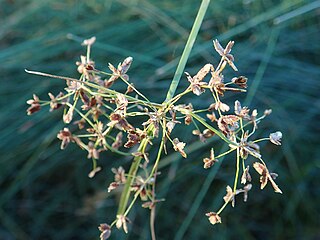
Cyperus polystachyos, also known as Pycreus polystachyos, and also called manyspike flatsedge in the US, or bunchy sedge, coast flatsedge, many-spiked sedge or Texas sedge in Australia, is a herbaceous species in the family Cyperaceae, widespread in tropical and subtropical areas around the world, sometimes extending its range into temperate regions.
Cyperus aquatilis is a sedge of the family Cyperaceae that is native to Australia and New Guinea.
Cyperus astartodes is a sedge of the family Cyperaceae that is native to northern parts of Australia.

Cyperus betchei is a sedge of the family Cyperaceae that is native to Australia.
Cyperus blakeanus is a sedge of the family Cyperaceae that is native to Australia.

Cyperus carinatus is a sedge of the family Cyperaceae that is native to northern Australia.
Cyperus castaneus is a sedge of the family Cyperaceae that is native to parts of northern Australia, southern Africa, India and south east Asia.
Cyperus centralis is a sedge of the family Cyperaceae that is native to arid areas of central Australia.

Cyperus concinnus is a sedge of the family Cyperaceae that is native to Australia, and found in New South Wales, Queensland, the Northern Territory, South Australia, Victoria and Western Australia.
Cyperus cracens is a sedge of the family Cyperaceae that is native to northern and north western parts of Australia.
Cyperus crispulus is a sedge of the family Cyperaceae that is native to Australia and found in Western Australia, and the Northern Territory.
Cyperus cunninghamii is a sedge of the family Cyperaceae that is native to Australia.
Cyperus hesperius is a sedge of the family Cyperaceae that is native to Australia.
Cyperus ixiocarpus is a sedge of the family Cyperaceae that is native to northern parts of Australia.
Cyperus latzii is a sedge of the family Cyperaceae that is native to Australia, and found in the Northern Territory and Western Australia.
Cyperus nutans is a sedge of the family Cyperaceae that is native to Australia, China, India, Bangladesh, south-east Asia, Malaysia, India, and Indonesia.
Cyperus portae-tartari is a sedge of the family Cyperaceae that is native to Australia, and found in the Northern Territory and Western Australia.
Cyperus pulchellus is a sedge of the family Cyperaceae that is native to northern Australia, tropical Africa, northwest Madagascar and Southeast Asia.
Cyperus viscidulus is a sedge of the family Cyperaceae that is native to north western Australia.
Cyperus vorsteri is a sedge of the family Cyperaceae native to southern Africa.



